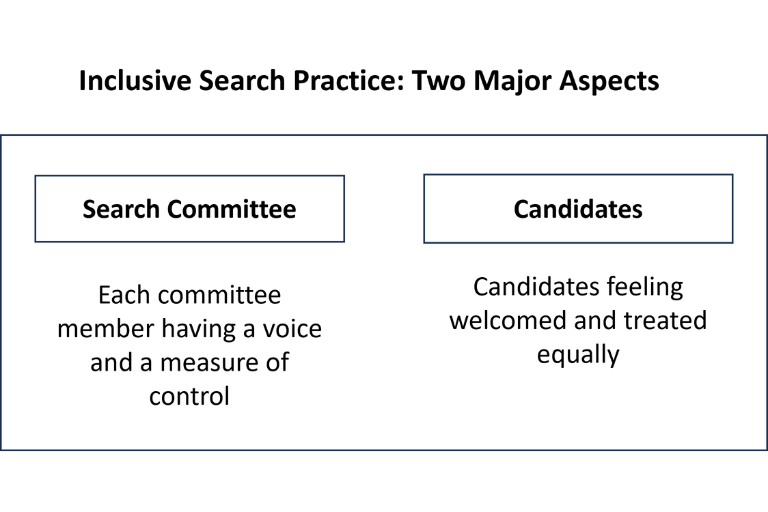Though we just started a new academic year, many departments on campus are already preparing for the next academic year by starting their new faculty hiring process. Inclusive hiring is one of the critical approaches to faculty hiring at Indiana University Bloomington. However, questions often arise about how to effectively incorporate inclusivity into the hiring process. In this episode, we explore how allyship and advocacy can enhance the faculty search process and offer three key practices for achieving equity in hiring. We hope this episode can provide insights to equip the current and future search committees with strategies to address biases and develop long-term plans for fostering a diverse academic community.

Inclusive Search Practice
Amy Crutchfield, a faculty search consultant, asserted that “inclusive hiring is one of those hot topics that everyone in higher education talks about but rarely with any specifics attached.” In other words, “how to” conduct an inclusive hiring process is often missing in conversations. To address this gap, Crutchfield identified two key pillars of the inclusive hiring process: inclusive search practices for committee members and for candidates.

Actionable Practices for Navigating the Hiring Process
Here are three actionable practices for navigating the inclusive hiring process.
- Challenge implicit bias.
Implicit biases, though varied, have a common consequence—perpetuating the marginalization of underrepresented scholars and their work.
Thus, the search committee should be able to identify and address different types of biases to ensure the process remains equitable and accurately measures excellence and innovation. Implicit biases to examine include:
- Bias around prestige
- Bias around emerging fields
- Productivity biases
- Biases in Letter of Recommendations:
- Biased standards
- Creating an interview environment where candidates can be themselves.
After addressing biases, the committee should create an interview setting where candidates can be authentic. It is essential to ensure that candidates from marginalized backgrounds do not face additional challenges. For example, the baby penalty disproportionately affects academic moms (e.g., mothers experiencing childcare-related stress during interviews, particularly on-site interviews). Nguyen and colleagues (2022) suggest several proactive strategies to support candidates:
“ Beyond organizing the schedule, the administrator reached out to every candidate to offer any support needed to facilitate their interview process. The goal here was to create an equitable process for all candidates despite the fact that they were interviewing from different places and potentially very different environments. Possible support could have included a hotel room for the duration of the interview, child or elder care, purchase of food, or anything else that would allow the candidate to have an optimal interview process and environment. At this time, the administrator also made inquiries about any scheduling requirements for the virtual interview that might be required such as the need to care for a child or address health or wellness needs. Only the administrator was part of the discussion and no member of the search committee or the faculty had any information about whether any candidate accepted this offer. This information was clearly communicated to the candidates to reassure them that taking advantage of this offer in any way would not be considered as part of the evaluation. The goal was to have an equitable process, which would also accommodate any individual needs of the candidates” (p. 5)
- Enhancing the departmental appeal to minoritized faculty.
A diverse faculty enriches academic excellence and innovation by offering varied perspectives on knowing and constructing knowledge (epistemology). It is also essential for programs and institutions to become more attractive and capable of retaining diverse faculty in pursuit of academic excellence. Minoritized candidates are, in fact, keen to evaluate whether they can thrive in the new department and institution. Candidates from minoritized backgrounds, thus, seek faculty that may provide a welcoming, collaborative, equity-conscious community and who may also understand and advocate for their research. In this regard, the programs/colleges must invest in educating and developing a culture of allyship and advocacy within each unit to be more attractive and equipped to support new faculty from marginalized backgrounds, which is also crucial in retaining them. In fact, there are examples of departments at different research institutions organizing departmental-level seminars on implicit biases.1, 2 Advocates & Allies for Equity at IUB also offers unit/department-based dialogue on gender equity and intersectionality.
Ally Resources
Video: Implicit Bias | Lesson 6: Countermeasures—This video guides the faculty search committee in developing countermeasures by decoupling the bias and criteria evaluation.
Article: Black Scientists Face a Big Disadvantage in Winning NIH Grants, Study Finds –This article shows how implicit bias can also influence faculty searches.
Request A&A Facilitation for your unit/department! It’s a unit/department-based semi-structured workshop on gender equity designed for transformational learning environment for men. For more information or for facilitation requests, please contact us at aaequity@iu.edu

